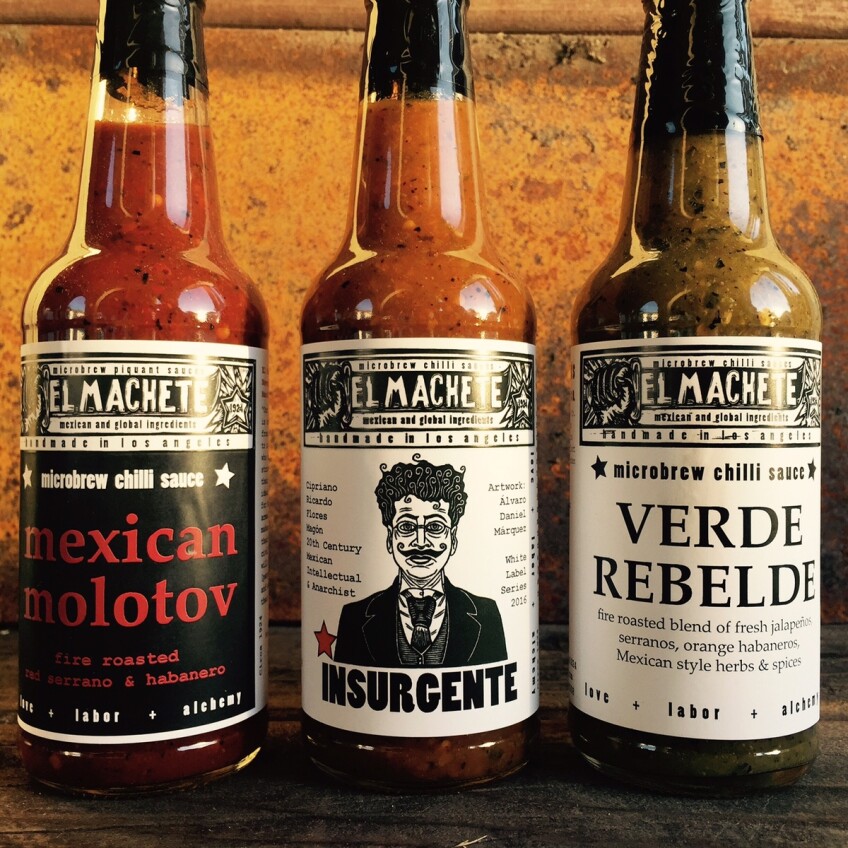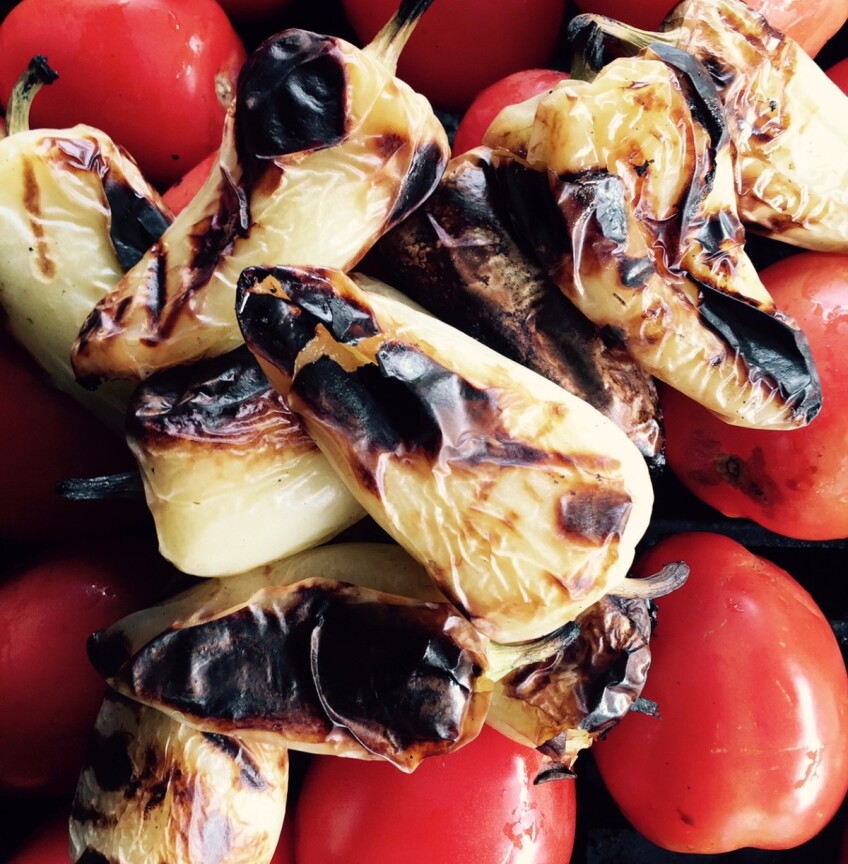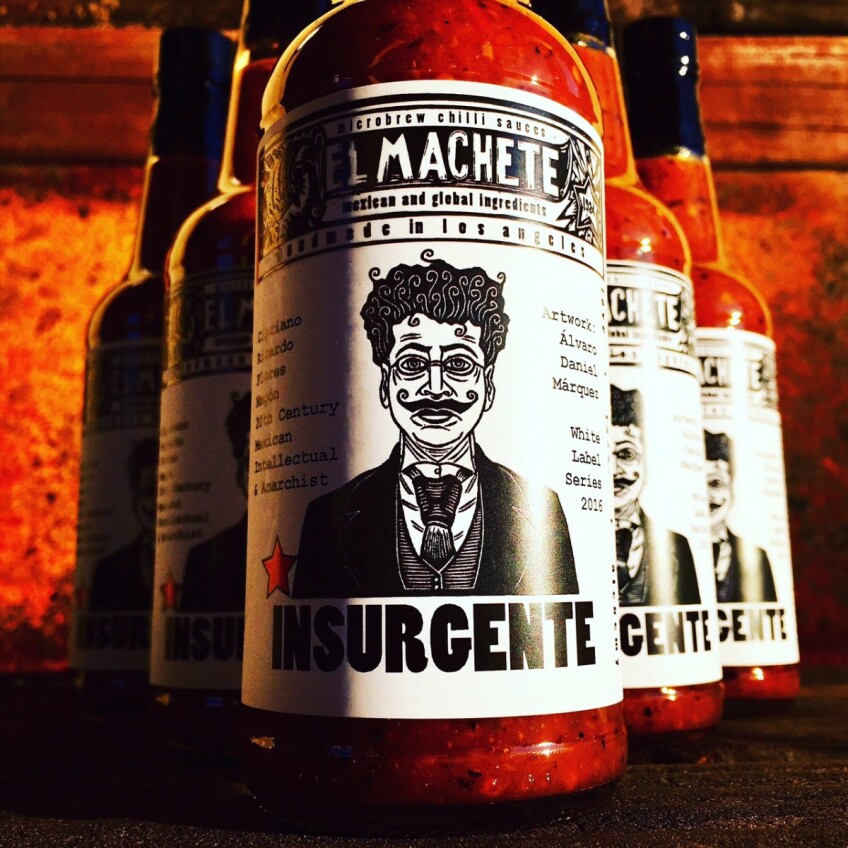El Machete's Small-batch Hot Sauce Inspired by Mexico's History and L.A.'s Global Palate

When Othón Nolasco, bar director at the hip Everson Royce Bar in L.A.’s Downtown Arts District, went on a search for the perfect hot sauce for his michelada, he didn’t just settle for the big names. He went with Oscar Ochoa’s El Machete hot sauce. Nolasco says the name-brand sauces just lacked the depth of flavor he needed. Plus, they were full of preservatives.
Chiles actually have a fascinating journey in becoming an essential global ingredient. Chiles have existed in the Americas for at least a million years...
No wonder El Machete received Nolasco’s seal of approval: it’s a nuanced product meant to ignite the fervor of heat seekers from both sides of the border. Over the past five years, owner Ochoa has been cultivating a salsa brand that combined his love of Mexico, history and his roots in Los Angeles. El Machete focuses on small-batch bottles made with quality Mexican (and local) ingredients: fire-roasted chiles from Mexico, California-grown garlic, Mexican cane sugar. Ochoa calls it “chilli” sauce, after the Nahuatl word for chile; the name El Machete comes from a leftist 1920s newspaper in Mexico City.
“The idea is to continue to celebrate Mexican history, the history of Los Angeles, and to celebrate art,” he says.

The sauces also pluck flavors from other global cuisines. The orange habanero Lucha Label Series sauce — which is particularly amazing dribbled over red beans and rice — includes mango, carrot, pineapple and ginger, inspired by some of the flavors of the Caribbean; the Neptuno sauce includes ghost chilies with anchovy, sundried tomatoes, Mexican spices and Tamari, a Japanese form of soy sauce.
Ochoa’s love of chiles started early.
As a kid, if he stayed overnight at a friend’s house, he’d pack a bottle of Tapatío hot sauce to drizzle on things like corned beef hash or canned Chef Boyardee raviolis. His dad liked to carry a raw serrano chile around in his pocket — they went well with sandwiches — so the younger Ochoa learned to nibble on raw chiles, too.

“I think it’s just in my DNA that I gravitate toward things that are hot,” says Ochoa, the son of Mexican immigrants who grew up in Boyle Heights and Pico Rivera. Frequent trips to Mexico with his family opened his eyes to the country’s complex flavors and ingredients.
He studied Mexican and Chicano history in college, which inspired him to want to share what he learned with others. Ochoa recently gave a talk about the history of chiles at downtown L.A.’s La Plaza de Cultura y Artes, where he told a mostly Latinx crowd how the Mexica culture (also known as the Aztecs) used a milpa, a traditional farming system that included chiles, beans and corn.
“Chile was understood to have medicinal qualities back then,” he says. “It’s shattering those old perspectives that Mexicanos are just about tacos. It’s like, come on, we have cultural patrimony and many histories there.”
According to "Capsicums Throughout History" by Janet Long, an essay that appears in the book "Chili: A Key Feature of Independence and the Revolution," chiles were used for medicinal purposes both before and after the Spanish conquest of Mexico.
In pre-Hispanic times, Long says a type of chile-infused tea was used to treat coughs; a mixture of hot chile and salt was used to cure cavity pain (both were pressed against the infected tooth), and chiles were used to initiate childbirth, among other uses. After the conquest, earaches were treated with chile drops boiled with wine. She says vinegar boiled with chile powder was also used to treat a toothache (again, after the conquest).
Chiles actually have a fascinating journey in becoming an essential global ingredient. Chiles have existed in the Americas for at least a million years, says Paul Bosland, director of the Chile Pepper Institute at New Mexico State University. The first chiles evolved near Bolivia in South America.
The early plants were eaten by birds and humans considered them “tolerated weeds,” says Dave DeWitt, a chile pepper expert and producer of Albuquerque’s Fiery Food Show. The first wild undomesticated chiles were chiltepíns, a tiny, oval-shaped, extremely hot chile that still exists today.
As birds spread the seeds — birds do not have heat receptors, so they could eat chiles with abandon — early civilizations saved the seeds and selectively planted their favorites. Eventually these early American farmers domesticated chiles into five distinct species: capsicum annuum, first domesticated in Mexico; capsicum baccatum, often called ají, which the Incas used; capsicum chinense, which includes habanero chiles, widely used by indigenous cultures in Eastern Mexico and the Caribbean; capsicum frutescens, which includes Tabasco chiles, and capsicum pubescens, which includes the Peruvian rocoto and manzano chiles.

It was Columbus who first sent chiles back to Spain, DeWitt says, launching the spread of chiles around the world. Columbus gave them the misnomer of “pepper,” thinking he’d stumbled on the highly sought-after Indian spice.
Today, as a direct result of New World colonization, chiles are an integral part of cuisines in India, Thailand, China and many countries in Africa. Capsicum annuum has become the world’s largest species, representing chiles including serranos, poblanos, bell peppers, Thai chiles, Hungarian paprika chiles and more.
Meanwhile, in the United States, chile culture is booming. There are 400 varieties in the nation alone, says DeWitt, who wrote “The Field Guide to Peppers.” Los Angeles doesn’t have a big boutique hot-sauce scene, but it is home to two of the biggest hot sauce brands in the country: Huy Fong’s Sriracha and Tapatío. A KPCC article also notes that it’s not the Tabascos of the world that are gaining market share, but the sauces that incorporate Asian or Mexican flavors.

Ochoa is still a relative underdog. He sells his products at the Hollywood Farmers Market, and he says he’s working on growing his distribution and launching initiatives that give back to the community that raised him. A recent batch of hot sauces has labels designed by a Chicano artist in Boyle Heights. He also recently launched a new line of rustic salsas called “Chilmolli,” after the Nahuatl words for chile sauce, and a chile oil. And he has other products in mind for his newly created umbrella company, Boyle Heights Chilli Sauce Co.
“It's hot sauce through a Mexican lens, designed to fit the Angeleno palate,” Ochoa says. “I want this brand to be connected to my whole community, to Eastside Los Angeles. When people buy a bottle of the sauce, I want them to think about what they’re investing in.”
Top Image: Fresno chiles | El Machete





